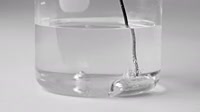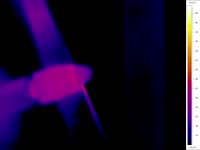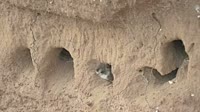Gallium beating heart experiment. A sample of gallium metal is placed in a beaker of warm sulfuric acid. The warmth melts the gallium, and the acid reacts with the surface of the metal, forming gallium sulfate. The molecules of gallium sulfate attract each other strongly, forming a skin that keeps the gallium in a round blob. When it is touched by an iron nail, the surface tension is disrupted, and the gallium begins to flow away. This breaks the connection to the nail, allowing the surface tension to draw the gallium back into a round blob, and forcing it to touch the nail again. This has the effect of causing the gallium to pulsate, like a beating heart.
Details
WebID:
C01842034
Clip Type:
RM
Super High Res Size:
1920X1080
Duration:
00:00:20.000
Format:
QuickTime
Bit Rate:
25 fps
Available:
download
Comp:
200X112 (0.00 M)
Model Release:
NO
Property Release
No













 Loading
Loading